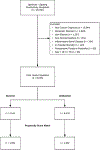First, Do No Harm: Rethinking Routine Diversion in Sphincter-Preserving Rectal Cancer Resection
- PMID: 30639302
- PMCID: PMC6424605
- DOI: 10.1016/j.jamcollsurg.2018.12.012
First, Do No Harm: Rethinking Routine Diversion in Sphincter-Preserving Rectal Cancer Resection
Abstract
Background: Although diverting stomas have reduced anastomotic leak rates after sphincter-preserving proctectomy in some series, the effectiveness of routine diversion among a broad population of rectal cancer patients remains controversial. We hypothesized that routine temporary diversion is not associated with decreased rates of leak or reintervention in cancer patients at large undergoing sphincter-sparing procedures.
Study design: The Florida State Inpatient Database (AHRQ, Healthcare Cost and Utilization Project) was queried for patients undergoing sphincter-preserving proctectomy for cancer (2005 to 2014). Matched cohorts defined by diversion status were created using propensity scores based on patient and hospital characteristics. Incidence of anastomotic leak, nonelective reintervention, and readmission were compared, and cumulative 90-day inpatient costs were calculated.
Results: Of 8,620 eligible sphincter-sparing proctectomy patients, 1,992 matched pairs were analyzed. Leak rates did not significantly vary between groups (4.5% vs 4.3%; p = 0.76), but diversion was associated with significantly higher odds of nonelective reintervention (2.37; 95% CI 1.90 to 2.96) and readmission (1.55; 95% CI 1.33 to 1.81) compared with undiverted patients. Median costs were higher among those diverted (US$21,325 vs US$15,050; p < 0.01).
Conclusions: No association between diversion and anastomotic leak was found. However, temporary diversion was associated with increased incidence of nonelective reinterventions, readmissions, and higher costs. We therefore challenge the paradigm of routine diversion in rectal cancer operations. Additional study is needed to identify which patients would benefit most from diversion.
Copyright © 2019 American College of Surgeons. Published by Elsevier Inc. All rights reserved.
Figures







Comment in
-
Discussion.J Am Coll Surg. 2019 Apr;228(4):556-559. doi: 10.1016/j.jamcollsurg.2019.02.021. J Am Coll Surg. 2019. PMID: 30885481 No abstract available.
References
-
- Hallbook O, Sjodahl R. Anastomotic leakage and functional outcome after anterior resection of the rectum. Br J Surg 1996;83:60–62. - PubMed
-
- Karanjia ND, Corder AP, Holdsworth PJ, Heald RJ. Risk of peritonitis and fatal septicaemia and the need to defunction the low anastomosis. Br J Surg 1991;78:196–198. - PubMed
-
- Huser N, Michalski CW, Erkan M, et al. Systematic review and meta-analysis of the role of defunctioning stoma in low rectal cancer surgery. Ann Surg 2008;248:52–60. - PubMed
-
- Fujita S, Teramoto T, Watanabe M, et al. Anastomotic leakage after colorectal cancer surgery: a risk factor for recurrence and poor prognosis. Jpn J Clin Oncol 1993;23:299–302. - PubMed
Publication types
MeSH terms
Grants and funding
LinkOut - more resources
Full Text Sources
Medical

